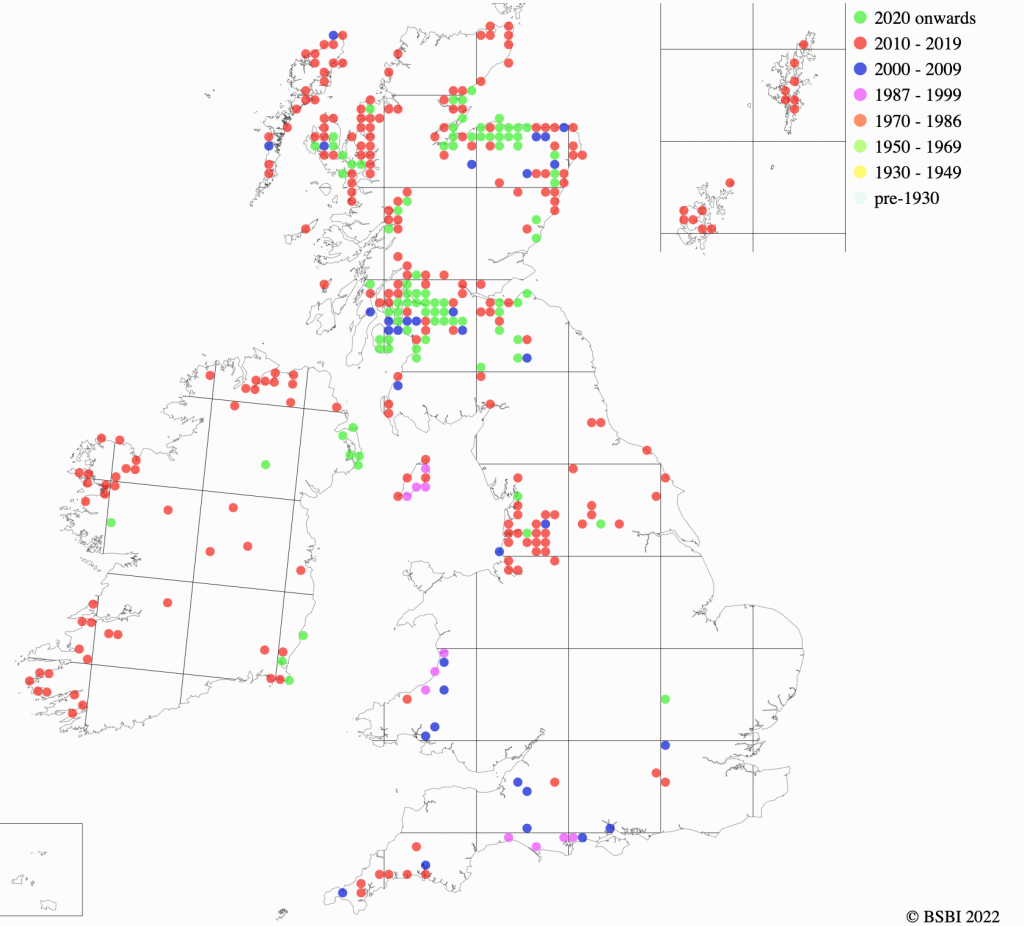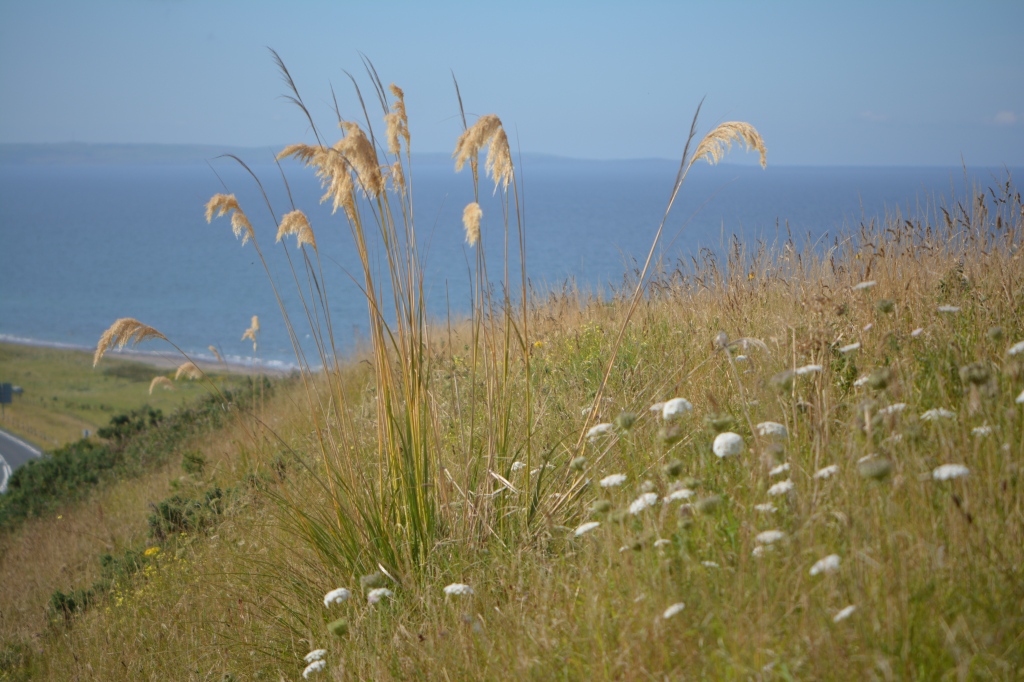Cortaderia richardii is a relative newcomer to British shores, first recorded in 1980 from cliffs at Lyme Regis in Dorset. It comes from the South Island of New Zealand where it is found on river beds, lake and stream margins and wet places. Its English name is ‘Early Pampas Grass’ to distinguish it from the later-flowering ‘Pampas Grass’ Cortaderia selloana a similar species from South and Central America. Both are widely available as garden ornamentals, and both have ‘escaped’ into the wild. C. selloana was introduced much earlier, in 1848.

Fully developed tussock of Cortaderia selloana in an Edinburgh garden – a fine specimen but how will the owner get rid of it when the tussock outgrows the garden? Photo: John Grace.
Both the species are among the giants of the grass family, Poaceae, and both can be seen decorating front gardens, forming large tussocks with graceful flowering stems up to three metres tall. In Scotland, particularly on the West, C. richardii is more common than C. selloana. Where I live in South Edinburgh I see it in neighbours’ front gardens where it occupies pride of place. I expect the gardeners who have cherished it so well will have great difficulty dealing with it when the tussock outgrows the garden. The leaves are sharp and strong, easily cutting flesh. In the road where I live, seedlings of C. richardii spring up in the roadside gutters from time to time.

Distribution of C. richardsii in the British Isles. From BSBI Maps.
In the last few years the Early Pampas Grass has become widespread in the wetter western parts of the British Isles, especially on sea cliffs, embankments and waste ground. It is strangely scarce in the South-East of England and London. High concentrations around Glasgow and Manchester point to the possibility that it has become ‘fashionable’ in the world of urban gardening, and has escaped multiple times from the front gardens of those cities. All this is happening quickly. In 2016 the Flora of Lanarkshire notes only two records. Looking north, the scattered Hebridean distribution cannot be explained by ‘escape from surburbia’ and my hypothesis is that seeds are blown long distances from the mainland by the prevailing SW wind (see below for comments re seed dispersal).



Escape of Cortaderia richardsii into the wild. From left to right: on the railway line leading to Stranraer station, on the sea wall at Stranraer, on a road embankment (A77 South Ayrshire). Photos: John Grace.
The climate of New Zealand’s South Island and Britain are somewhat similar, broadly ‘temperate maritime’, but South Island’s rainfall is only 650 mm per year and its temperatures are somewhat higher than those of northern Britain. At Christchurch, New Zealand the mean maximum temperature is 23 oC in summer and 12 oC in winter. From this, one might expect Cortaderia richardii to prefer the warmer and drier parts of Britain rather then the West and North of Scotland; but no, it is more common in the wetter and cooler parts.

C. richardsii has colonised the gutter of an urban street – in fact, the street in Edinburgh where I live. This demonstrates how garden specimens have produced viable seeds (last year I guess) and the seedlings can withstand the harsh conditions prevailing by the roadside. Photo: John Grace.
Its introduction to Britain is so recent that it isn’t mentioned in Stace’s first edition of the New Flora of the British Isles published in 1991. It does occur in later editions and in the BSBI’s book on grasses (Cope and Gray, 2009). In the past, I confess that some of us have recorded it as Cortaderia selloana, not knowing of the existence of Cortaderia richardii. Now there is no excuse. Fortunately the two species are easy to tell apart. C. selloana has flowering spikes that stand erect like lollypops but C. richardii’s flowering spikes form a graceful arc (they are ‘pendulous’). The leaf anatomy is different: both have a tough midrib and many other ribs but in C. richardii every 4th to 8th rib is strengthened and thicker. In fact, most people cannot rip apart the leaf of C. richardii whereas C. selloana is rippable.


Left: the hairy lemmas and long awns of C. richardii, perfect for long-distant transport perhaps? Right: underside of leaves of C. richardii on the left and C. selloana on the right (note the strong ‘ribs’ of C. richardii). Photos: John Grace.
New Zealand sources now call it Austroderia richardii (de Lange 2022) with synonyms that include Arundo richardii and Cortaderia richardii. So does the author of the current Wikipedia article. However, in Plant of the Week we prefer to follow Stace (2019) to avoid confusion.

A neglected garden. C. richardii has seeded itself repeatedly and now is the dominant species. Location: Riverside Inn, north of Minishant on the A77 road in Ayrshire, SW Scotland. Photo: John Grace.
In its native range about half of the individuals are female and about half are hermaphrodite. The hermaphrodites of C. richardii set seed readily and by now (early August) almost all the seed has been shed. I was fascinated to see that the florets have long silky hairs growing from the base of their lemmas; each floret can therefore be carried far in the slightest breeze. Very few grasses have this arrangement, which must contribute hugely to mobility the species. I think that the seeds can be ‘sucked along’ in the wake of trains and fast vehicles, and may help to carry seeds beside railway lines and roads. Another grass with hairy propagules is the Common Reed, Phragmites australis, but this pattern is rare in the Poaceae (I can’t think of another, but see Zotov 1963 for line drawings of New Zealand species).
Of the many hundreds of exotic species grown in gardens only a small fraction escape. But this one is an ‘escaper’ for sure. I notice that the species has the Royal Horticultural Society’s Award of Garden Merit, and that there are several on-line suppliers. So we may presumably look forward to seeing more of it growing in the wild. So far, there is only one single Northern Hemisphere record outside the British Isles – it is on the coast of Norway. My considered opinion is that within ten years it will be classed as an invasive alien throughout Europe.
References
Cope T and Gray A (2009) Grasses of the British Isles:13 (BSBI Handbooks)
de Lange P.J (2022) Austroderia richardii Fact Sheet (content continuously updated). New Zealand Plant Conservation Network. https://www.nzpcn.org.nz/flora/species/austroderia-richardii/
Macpherson P (2016) The Flora of Lanarkshire. Pisces Publishers.
Stace CA (2019) New Flora of the British Isles. C&M Floristics.
Zotov VD (1963) Synopsis of the grass subfamily Arundinoideae in New Zealand, New Zealand Journal of Botany, 1:1, 78-136, DOI: 10.1080/0028825X.1963.10429323
©John Grace
I actually put a bit on Facebook which I meant to go here. Good article as usual BUT -This plant is out of control in Asturias, a serious pest that the government has given up on. I can’t begin to say how crucial it is the same doesn’t happen in Scotland, especially the west whose climate is so like here in Asturias. It should be put on the INNS list!
LikeLike